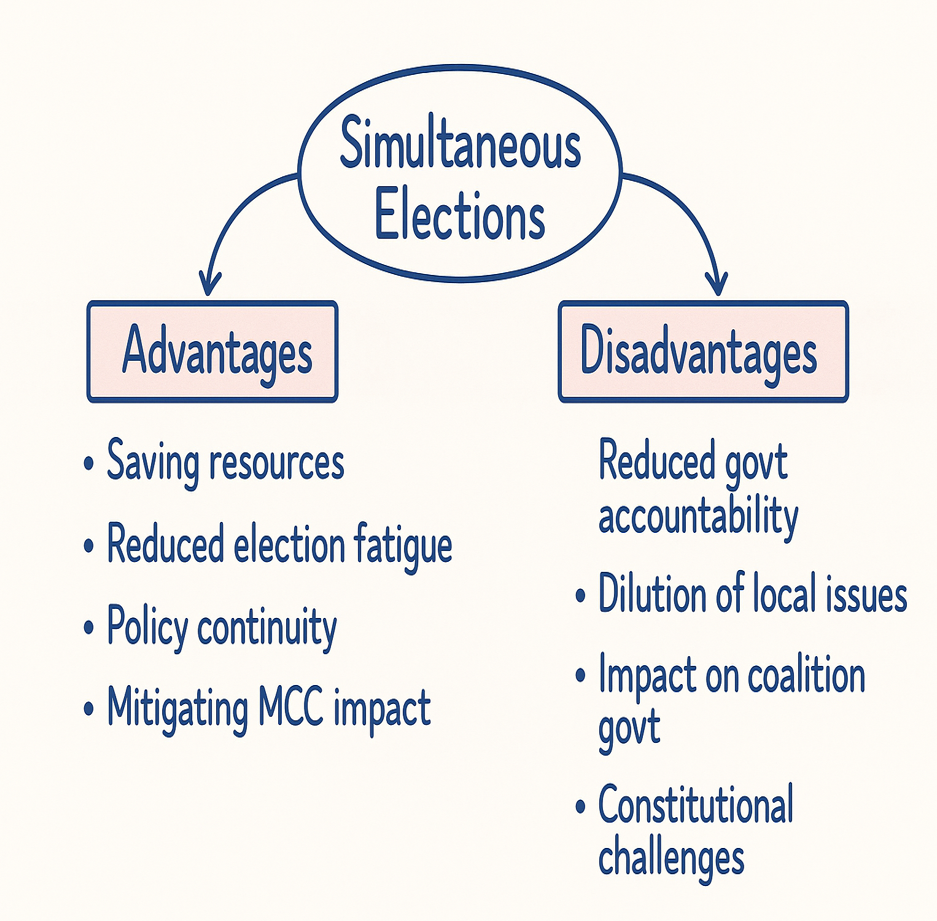There are no items in your cart
Add More
Add More
| Item Details | Price | ||
|---|---|---|---|
Mon Jun 30, 2025
పరిచయం:
1952 నుండి 1967 వరకు, భారతదేశంలో లోక్సభ మరియు రాష్ట్ర శాసనసభలకు ఏకకాలంలో ఎన్నికలు నిర్వహించారు. అయితే, శాసనసభల ఆకస్మిక రద్దు కారణంగా ఈ సంప్రదాయం భంగపడింది. 2019 నాటికి, కేవలం నాలుగు రాష్ట్రాలు మాత్రమే ఏకకాల ఎన్నికలను నిర్వహించాయి. భారత ఎన్నికల సంఘం మరియు న్యాయ కమిషన్ ఈ ఆలోచనను పునరుజ్జీవనం చేసినప్పటికీ, ఇది రాజ్యాంగ మరియు రాజకీయ చర్చకు మాత్రమే పరిమితమైంది.
విషయం:
I. ఏకకాల ఎన్నికల ప్రయోజనాలు
1. ఖర్చు సామర్థ్యం
a. పునరావృత ఎన్నికల ఖర్చును తగ్గిస్తుంది. లోక్సభ ఎన్నికలు ఒక్కటే సుమారు ₹4,000 కోట్ల ఖర్చును కలిగిస్తాయి.
b. ఏకకాల ఎన్నికలు ఎలక్ట్రానిక్ ఓటింగ్ మెషీన్లు మరియు ఓటింగ్ సౌకర్యాల వంటి సేవలను సమన్వయం చేస్తాయి.
2. పాలనా నిరంతరత
a. తరచూ జరిగే ఎన్నికలు ఎన్నికల నియమావళి (మోడల్ కోడ్ ఆఫ్ కండక్ట్) అమలుకు దారితీస్తాయి. ఇది విధాన నిర్ణయాలను అడ్డుకుంటుంది.
b. ఏకకాల ఎన్నికలు ప్రభుత్వాలకు దాదాపు ఐదేళ్ల స్థిరమైన విధాన నిర్ణయ కాలాన్ని అందిస్తాయి.
3. పరిపాలనా సౌలభ్యం
a. పౌర మరియు భద్రతా సిబ్బంది యొక్క పునరావృత వినియోగాన్ని తగ్గిస్తుంది.
b. 2014లో, లోక్సభ మరియు నాలుగు రాష్ట్రాల ఎన్నికలకు 2,400 కంటే ఎక్కువ కేంద్ర సాయుధ పోలీసు బలగాలు అవసరమయ్యాయి.
4. సామాజిక మరియు రాజకీయ అల్లకల్లోలం తగ్గింపు
a. తరచూ జరిగే ఎన్నికలు కుల మరియు సామాజిక సమీకరణను పెంచుతాయి.
b. ఒకే ఎన్నికల చక్రం ధ్రువీకరణను తగ్గించి, సామాజిక సమైక్యతను నిలబెడుతుంది.
5. అంతర్జాతీయ అనుభవాలు
a. దక్షిణాఫ్రికా మరియు జర్మనీ వంటి దేశాలు నిర్దిష్ట కాలపరిమితితో జాతీయ మరియు ప్రాంతీయ ఎన్నికలను సమకాలీకరించి నిర్వహిస్తాయి.
II. సవాళ్లు మరియు ప్రజాస్వామ్య ఆందోళనలు
1. జవాబుదారీతనం తగ్గుదల
a. మధ్యంతర ఎన్నికలు ఓటర్లకు అసంతృప్తిని వ్యక్తపరిచే మరియు పాలనను ప్రభావితం చేసే అవకాశాన్ని అందిస్తాయి.
b. ఏకకాల ఎన్నికలు ఈ ప్రతిస్పందన చక్రాన్ని తగ్గిస్తాయి.
2. సమాఖ్య స్వభావం బలహీనత
a. రాష్ట్ర-నిర్దిష్ట సమస్యలు జాతీయ ఎజెండాల ఆధిపత్యం నీడలో పడవచ్చు.
b. ఎస్. ఆర్. బొమ్మై వర్సెస్ యూనియన్ ఆఫ్ ఇండియా (1994) తీర్పులో రాజ్యాంగ మౌలిక స్వరూపంగా గుర్తించబడిన సమాఖ్య స్వభావం రాజీపడవచ్చు.
3. ఓటరు ప్రవర్తన మరియు వక్రీకరణ
a. అధ్యయనాల ప్రకారం, ఎన్నికలు ఏకకాలంలో జరిగినప్పుడు 77% ఓటర్లు రెండు స్థాయిలలో ఒకే పార్టీని ఎన్నుకుంటారు. దీనివల్ల స్థానిక సమస్యల ఆధారంగా విభిన్న ఓటింగ్ తగ్గుతుంది.
4. రాజ్యాంగ మరియు చట్టపరమైన అడ్డంకులు
a. శాసనసభల కాలపరిమితిని సమకాలీకరించడానికి మరియు ఆకస్మిక రద్దు సమస్యలను పరిష్కరించడానికి ఆర్టికల్ 83, 85, 172, 174, మరియు 356లలో సవరణలు అవసరం.
5. రామ్నాథ్ కోవింద్ కమిటీ సిఫార్సులు
a. a.దశలవారీ అమలు: లోక్సభ మరియు సగం రాష్ట్ర శాసనసభలకు ఒక చక్రం, 2.5 సంవత్సరాల తర్వాత మరొక చక్రం అమలు చేయాలి.
b. అవిశ్వాస తీర్మానాలను ఏకకాల విశ్వాస ఓటుతో అనుసంధానించాలని సూచించింది. తద్వారా నిరంతరత నిర్ధారితమవుతుంది.
c. అల్లకల్లోలం తగ్గించడానికి ఉప-ఎన్నికలను సంవత్సరానికి ఒకసారి నిర్వహించాలని ప్రతిపాదించింది.
d. ఆకస్మిక రద్దు జరిగిన సందర్భంలో నిర్దిష్ట అవశిష్ట కాలాన్ని ప్రతిపాదించింది. ఇది ఎన్నికల సమయం దుర్వినియోగాన్ని నిరోధిస్తుంది.
